As many as 300 Lime bikes are being illegally hacked in London a week – as the controversial cycle hire company is hit with huge numbers of complaints for dangerously dumped vehicles.
A gallery of recent images assembled by MailOnline shows how frequently the branded e-bikes have been dumped in locations that make them a menace for pedestrians or a danger to motorists.
Now MailOnline has established the alarming scale of how many bikes have been effectively stolen from the company at any time – meaning they have no knowledge of who is using them and no control over where they end up being left.
With as many as one per cent of the 30,000 plus Lime bikes now in London having been hacked at any one time, that means up to 300 vehicles have been rogue on the city’s streets – and it’s thought that at its worst point that figure was as high as 1,500.
And tens of thousands of young Londoners are thought to have worked out how to take a Lime without registering or paying – which is known as ‘hacking’.
And while the company fines users who park in an unacceptable way, it has no control over hacker riders who face no such disincentive.
Consequently, dumped Lime bikes have become a scourge in London in recent years with many of them thought to have been hacked.
So each day dozens of the green and white battery powered e-bikes are strewn across payments, obstructing pedestrians or worse.
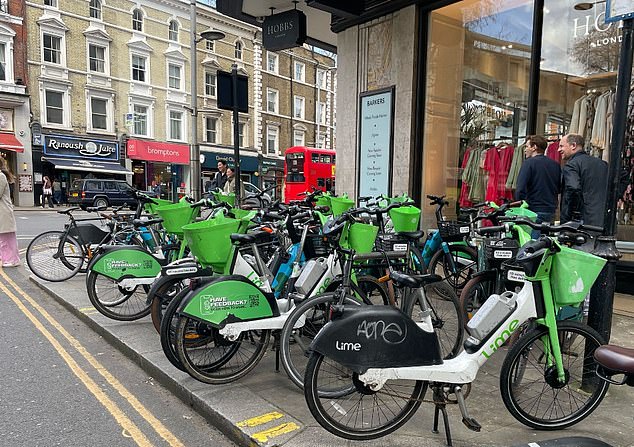
As many as 300 Lime bikes are being illegally hacked in London a week – as the controversial cycle hire company is hit with huge numbers of complaints for dangerously dumped vehicles
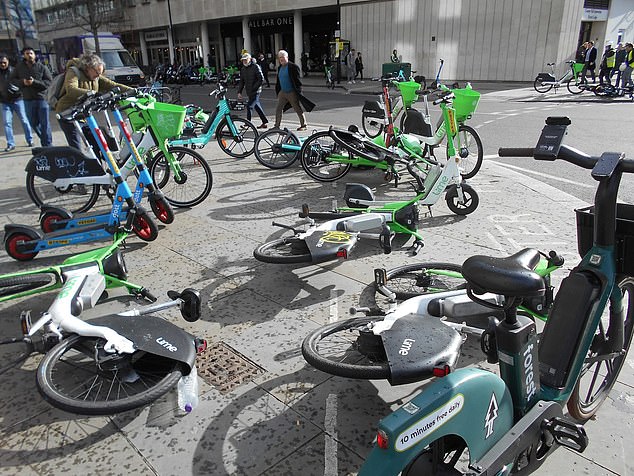
A gallery of recent images assembled by MailOnline shows how frequently the branded e-bikes have been dumped in locations that make them a menace for pedestrians or a danger to motorists

Dumped Lime bikes have become the scourge of city centres across the country and many of them are thought to have been hacked

An Instagram user posted an image of a Lime bike abandoned in Leg of Mutton Pond in Bushy Park, Richmond, London
They have become a plague for many as they find their way to the shops or pub blocked by a Lime bike.
Introduced as a green and cost-efficient way to get about town they have become a popular mode of transport especially for young Londoners and there are thought to be more than 30,000 in London alone.
Lime is guarded about disclosing detailed operational information but a spokesperson did insist the issue has improved significantly in the last 18-24 months since the number hacked is thought to have peaked at around 1,500 at any time.
But even their latest figures would equate to around 300 bikes from their fleet being rogue today.
An official company statement said: ‘Antisocial behaviour is rare and hacked trips now account for 1% of total trips.
‘We are committed to addressing any instances of antisocial behaviour, as this is not how we intend our service to be used.
‘While most users ride responsibly, we encourage the public to report any instances of antisocial behaviour to us, including the location and time, so we can investigate and take appropriate measures.’
The most popular boroughs in the capital for them are Hackney, Southwark, Islington, Wandsworth and Lambeth.

With as many as one per cent of the 30,000 plus Lime bikes now in London having been hacked at any one time, that means up to 300 vehicles have been rogue on the city’s streets – and it’s thought that at its worst point that figure was as high as 1,500
According to Lime more than four million Londoners have chosen their bikes since they were launched in 2018, and 16 million commuting journeys were made on them last year alone.
Comedian James Corden and singer Harry Styles have been spotted riding on Lime bikes in north London, adding to their popularity with Lime even confirming it led to a surge in their use.
Half of Londoners aged 18-34 use the bikes on a weekly basis – many to get home from a late night out at the pub and although the majority park responsible at the end of the journey many are just dumped.
A flick through social media reveals images of bikes blocking pavements and alleyways and even dumped on zebra crossings creating an obstacle course for pedestrians and those in wheelchairs or pushing buggies.
One image on X posted showed more than a dozen bikes parked up on a traffic island in Piccadilly in central London, blocking off the kerb.
The poster writing: ‘How are people supposed to use the pedestrian crossings on Piccadilly when Uber Lime bikes are strewn across the pavements turning every step into an assault course.’
Another showed a Lime bike on a zebra crossing on Brook Street in central London creating a hazard not only to pedestrians but to motorists as well.
Furious Charles Buchisky posted a picture of half a dozen bikes and scooters lying on the floor outside a parade of shops in Edgware, north Lonon, where he lives and wrote:’ I am sick and tired of these blinking Lime bikes they just seem to be dumped anywhere.

An Instagram post decrying two abandoned Lime bikes, one in the Thames and then one obstructing a crossing at London Bridge

Lime bikes lie scattered chaotically across the pavement in Charlton, London with no thought for pedestrians, wheelchair users or parents with prams
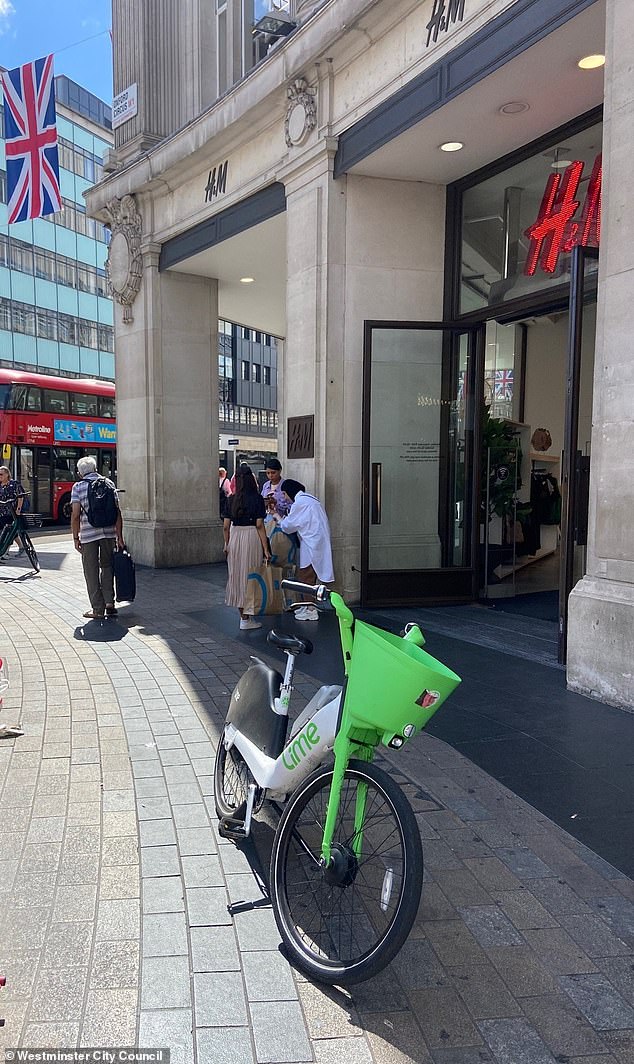
A Lime bike randomly left dumped on the pavement outside H&M on Oxford Circus in central London
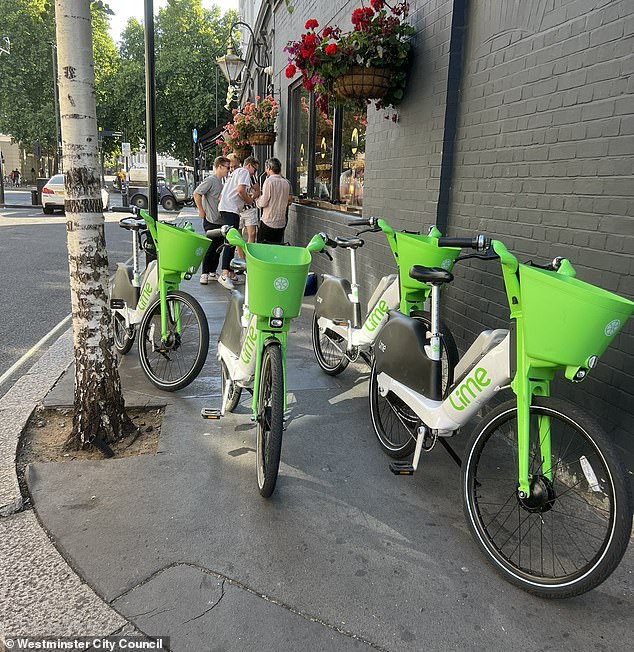
Two Lime bikes completely block the pavement in a shot posted by Westminster City Council
‘I have mobility issues and people in wheelchairs have to negotiate round them. There is no help line to ring at Lime bikes so I’ve had to put this on social media. Someone from Lime bikes needs to sort this out.
‘No control whatsoever. It’s disgusting.’
Charties such as the Sight Loss Council and the National Federation of the Blind of the UK have raised the issue multiple times saying badly parked or abandoned bikes cause trip hazards and obstacles.
But it’s not just in London other images show bikes dumped in Nottingham, Manchester and Derby usually in the busy centres or more often than not in surrounding rivers and canals creating irony of irony pollution issues.
The bikes work using an app and cost a flat fee to unlock and then a further amount based on how long they are ridden for.
But as they are ‘dockless’ riders can register, pay and unlock a bike and ride off to their destination where although Lime encourages them to use designated bays or park responsibly many are not.
On the Lime website there is a guide on how to park and users are asked to be ‘always considerate of other pavement users in areas with no dedicated parking bays or racks available’.
A step-by-step guide – including photographs – advisers riders to park close to the edge of the pavement with wheels parallel and in line with lamp posts, bins and trees.
They are also advised to ‘leave a space for wheelchair users, pushchairs, cars and others’ and if the area is too small to park without causing an obstruction, park elsewhere’.
However, that guidance appeared to have been too complicated for some after dozens were abandoned on a corner at Regent Place in central London, blocking the pavement to vehicles.
Vincent Stops, a former Hackney councillor, posted a picture of the chaos and wrote:’ The cargo bike couldn’t get through the dumped Lime bikes and pedestrians couldn’t use the pavement. Amazing how politicians have been entranced by the cycle lobby.’
Lime asks users to take a picture of how the bike is parked to ensure rules are followed and the fine for not following the rules was recently raised from £2 to £10.
Repeat offenders can be charged £20 and those who persistently fail to park properly can be banned from the scheme.
Lime is based in San Francisco, but its UK policy director is Hal Stevenson and he has been quizzed several times about the problem of bikes littering pavement causing an eyesore and an obstruction.
Earlier this year the company said it was investing £5 million to try and solve the parking issue with at least 2,500 more spaces and adding 100 new staff to its Parking Patrol team.
They are responsible for removing and redistributing poorly parked e-bikes from crowded or illegal locations and have a fleet of vans at their disposable to collect the estimated 4,000 badly parked bikes in London.
New AI technology is also being introduced which will be able to tell from the ‘end ride photo’ if the bike has been correctly parked and if it hasn’t users will not be able to terminate their journey.
Speaking of the bad parking scourge Mr Stevenson said:’ We understand the importance of preventing pavement obstructions across London and have made a number of investments in our technology.


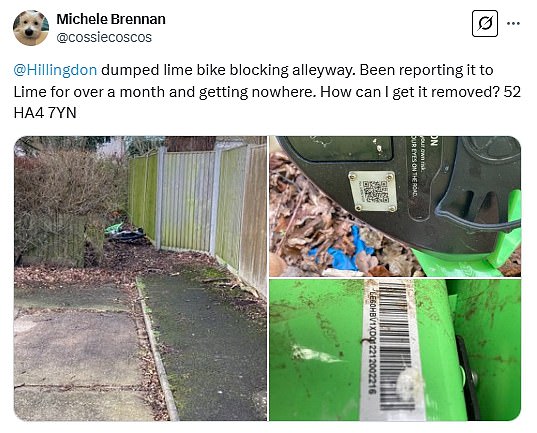
A series of three Instagram posts featuring users complaining about Lime bike users dumping the vehicles in inappropriate places – in one instance in a pod

A Lime bike is left propped up against a dustbin
‘Th most frequent complaint we now receive is about overcrowded parking locations, rather than individual vehicles being left where they shouldn’t.’
However, the problem has grown in recent months after a Tik Tok video went viral recently which showed how easy it was to ‘hack’ a Lime bike and cycle away without paying.
It leads to a distinctive clacking noise and although Lime says it has managed to crack down on the phenomena it is still quite commonplace among children cycling to school who then dump the bikes.
Another issue is that Lime takes no responsibility for bikes that are parked badly and fall onto cars causing damage and says the users are responsible, but it will not reveal who that person was.
While some boroughs have had enough and have begun getting their own back – earlier his year Kensington and Chelsea charged Lime £2,500 after 30 if its bikes were seized near Harrods after they had been badly parked.
Cllr Cem Kemahli, Kensington and Chelsea’s lead member for planning and public realm, said:’ We remain supportive of rental e-bikes but there is a line. Where abandoned bikes are putting pedestrians and drivers in danger, we are acting now to remove them.’
Earlier this year, Lime launched a £20m ‘London Action Plan’, designed to help improve e-bike parking, encourage cycling safety and boost cycling rates across London.
This saw them hire over 100 new on-street team members to get to badly parked -e-bikes more quickly.
The strategy also involves educating users to deter illegal behaviour, such as running red lights and parking in unauthorised areas.
The Department for Transport and Transport for London referred MailOnline to local councils when asked what was being done to keep pavements clear of e-bikes.
A Department for Transport spokesman said: ‘Local authorities already have powers to remove e-cycles from pavements where they are causing an obstruction and are responsible for working with rental operators to keep pavements clear where possible.’











